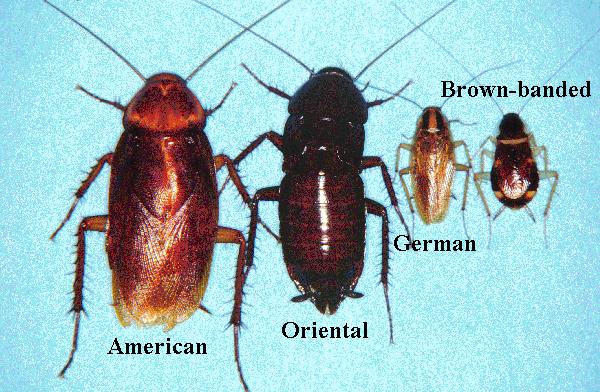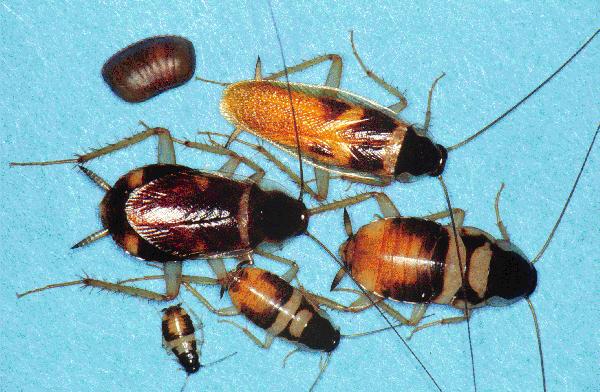
Even though there are about 4000 roach species in the world, and only 30 species live in our habitats, there are only about 5 types that are quite common and can pose a health risk to your family.
It’s no doubt that roaches are creatures no one wants to see around them; they are dirty, cause diseases and even allergic reactions. So which specific roach species should you look out for?
GERMAN COCKROACH
The only way you can differentiate this roach species from the rest is through its two dark lines that run from its head to the base of its wings.The colors vary, between brown, black and tan and it’s about 0.5 inches in size.
You should be wary of having a German roach in your home because recent studies have established that they have the fastest reproduction rate when compared with the other 4 species. Additionally, a baby roach will grow to an adult in less than 120 days, which only means that you will have a very high infestation within no time.
AMERICAN COCKROACH
This is considered the largest, of the 4 species we will list today, at about 1.5 inches long and 0.25 inches tall. You will identify the American cockroach through its reddish brown appearance, with a flat body. However, the young roaches do not have wings.
Due to its very large body size, this type of roach is not very common in households. However, these roaches have a very long lifespan, up to 2 years, which can cause you sleepless nights if you are trying to eradicate them.
BROWN BANDED COCKROACH
The only way you will differentiate these roaches from the German species is from their yellowish bands that run across their bodies. True to their name, these roaches have a reddish brown to a dark brown color and measure about 0.5 inches in size.
Another factor that sets them apart is the fact that they prefer dryer and warmer areas than their counterparts. You will mostly find them in bathroom and kitchen cabinets.
ASIAN COCKROACH
The Asian roach species is also very similar in size and shape to the German cockroach. Measuring just a little over 0.59 inches in length and a brown or tan color, these are among the few roach species that can fly and are attracted to light.
This is a unique roach species because they are also very active during the day. Keep in mind that cockroaches are nocturnal and rarely will you see them crawling around in broad daylight.
ORIENTAL COCKROACH
When it comes to size, the Oriental roaches come in a close second after the American species, measuring about 1 inch long, and in a dark brown to black color.
Female Oriental roaches have a wider body, with wings that are shorter than the males. Only the male ones are capable of flight, covering only short distances. You will identify this type easily because unlike the rest of the species, these are rarely found indoors unless it’sins the basement. Moreover, they will mostly infest drains and porches.
WRAPPING UP
We have mentioned the most popular roach species, those that you will mostly find in your home, whether inside or outside. If you identify any of them scurrying about, it’s the high time you settled on an effective eradication method.
STOP THEM FROM HATCHING: HOW TO KILL COCKROACH EGGS
Whenever you encounter some roach eggs in your home, this is a clear indication of a roach infestation. Keep in mind that these eggs present a bad situation, just as finding actual roaches crawling around.
Roach eggs don’t need the adult roaches to hatch. Quite on the contrary; any moist and dark place can give them the right environment for this. Either way, you need to come up with a plan to stop them from hatching to prevent having a roach problem in the house.
HOW TO IDENTIFY ROACH EGGS
The number of eggs in one sac vary, depending on the roach species in your home. For instance, the German cockroach has about 50 eggs in a sac, with the American one having about 16 eggs. The sac (oothecal) is a hard case that protects the gees from all harm until they hatch.
One of the ways to identify the type of roach that’s in your home is through its eggs. The sacs are elongated and tend to have a similar shape, resembling a pill. The only difference comes in color, which is precisely what will help you identify the exact species.
The German roach produces a brown sac, American roach has a dark brown sac, Brown Banded roach produces a light brown sac with some shades of red, and finally, the Oriental species has a medium to dark reddish brown sac.
Just like the adults, you will find roach eggs in pretty much the same locations; behind appliances, under sinks and cabinets, along floorboards and in between cracks and crevices.
A popular trick you can use is laying out some glue traps in those areas and once a few sacs or roaches are caught, you can study their physical characteristics and be able to automatically determine the roach species.
KILLING THE EGGS
This is one of the hardest roach elimination processes because the eggs are not as mobile as the adults, and the sac renders them immune to most pest control chemicals. Moreover, the methods that work for the adults will not work on the eggs. So how do you go about this?
To begin with, focus on killing the adult roaches. You can use any method you see fit for the elimination, from commercial killers like baits and boric acid to homemade solutions. This ensures that there is no more reproduction taking place, hence no more egg production.
Next, it’s time to kill the eggs. If you have identified some of their hiding places, you should now use a gel or any residual product that will either kill them or render them sterile such that the reproduction process is stopped. Gentrol is a popular commercial product with a high success rate known for killing roach eggs.
If you encounter egg sacs, we recommend either vacuuming them or collecting them and taking them as far as possible from your house, where you can burn, squash, spray with pesticides or cover with an insect growth regulator.
After that, you should work on preventing these roaches from finding their way back to your house. This is mainly through getting rid of any attractants, such as clutter, food stains, leaking pipes and unsealed cracks

2 thoughts on “ROACH SPECIES AND HOW TO KILL ROACH EGGS”